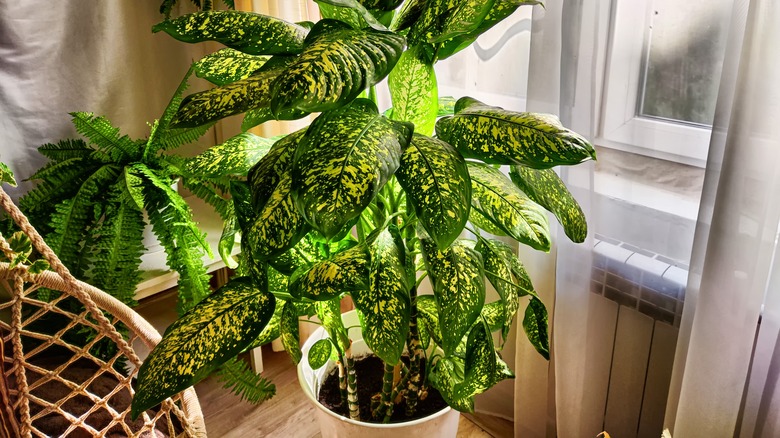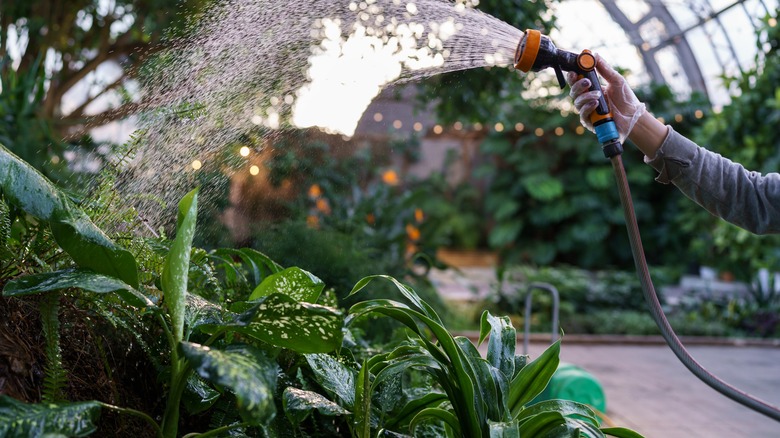Why You Might Want To Consider Not Growing Dumb Cane In Your Home
Houseplants offer an aesthetic appeal to your home, but not all make suitable indoor companions. Dumb cane, also known as Dieffenbachia, is one stunning yet problematic plant that, despite its visual appeal, you might want to consider not growing in your home. While incredibly easy to grow and visually striking with its lush, patterned foliage, this genus carries a hidden danger that belies its beauty. Its name, "dumb cane," stems from the adverse reactions it can cause if its leaves or stems are chewed. The plant harbors oxalate crystals — resembling needles — throughout its structure, rendering all parts of it poisonous. Ingestion can lead to severe pain, swelling of the mouth, and a burning sensation on the tongue, with the potential for extreme swelling to obstruct breathing, posing serious health threats to humans and pets alike if large quantities are consumed.
Originating from the warm climates of the New World Tropics, dumb cane is a perennial, thriving for years under the right conditions. Its leaves, beautifully variegated with white, cream, or yellow, make it a sought-after choice for interior decoration. Despite its visual appeal, the significant risks associated with the plant cannot be overlooked, and you'll need to weigh the aesthetic benefits against the potential danger it presents. Especially in homes with curious pets or young children, the potential hazards make it worth considering other safer and easier-to-grow houseplants.
Growing dumb cane safely
If you're still inclined to grow dumb cane, taking it outside might be a safer bet to mitigate the risks associated with its toxic nature. Opting for a partially shaded yet cozy corner outdoors makes a perfect compromise, safeguarding the plant from the cold that it dislikes. Interestingly, dumb cane is also resilient in full shade — this, along with its preference for diffused sunlight, is what makes it a popular indoor plant choice. However, by placing it in an outdoor location, you also lessen the chance of curious pets or children ingesting it.
If you're still committed to growing it, whether indoors or out, dumb cane flourishes with regular watering schedules — just make sure the soil has a chance to dry out a bit before giving it another drink. This plant isn't fussy about soil as long as it's of good quality and offers excellent drainage to allow the right amount of nutrients without the risk of root rot from excessive moisture. And as it grows, you'll find that repotting becomes necessary to give it the space it needs to spread out and continue thriving. However, it's crucial to exercise caution when handling the plant. When it's time to prune or handle it, slip on a pair of gloves that can protect you from the irritating sap, keeping your gardening experience safe and enjoyable.
Alternatives to dumb cane
If you prefer not to deal with the risks associated with dumb cane, it might be best to opt for other alternatives. Whether you're a seasoned plant enthusiast or a novice looking to green up your living space, there's no shortage of safe, equally attractive plants for any indoor environment. Consider the spider plant (Chlorophytum comosum), native to tropical and southern Africa. It thrives in indirect sunlight and requires moderate watering, making it an ideal plant for beginners. For an option that brings not only greenery but also elegant blooms into your space, the Peace Lily (Spathiphyllum) stands out. This plant, native to the tropical zones of the Americas and southeastern Asia, is prized for its beautiful white flowers. Peace lilies adapt well to low and moderate light environments and thrive with consistent moisture, careful to avoid overwatering.
If you're seeking a pop of color without the hassle, the African violet (Saintpaulia) might be the perfect choice. Originating from Tanzania and Kenya, this plant offers velvety leaves and vibrant flowers in shades of violet, pink, or white. It thrives in bright, indirect light and enjoys consistent moisture, with room to dry out slightly between waterings. Opting for these alternatives can provide the beauty and benefits of indoor plants without the dangers posed by dumb cane.


